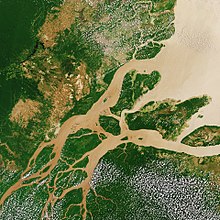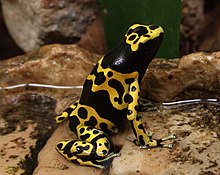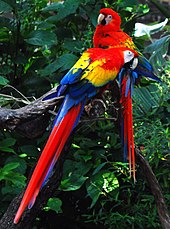Amazon rainforest
![]()
This article or section needs revision. More details should be given on the discussion page. Please help improve it, and then remove this tag.
The Amazon rainforest covers large parts of the Amazon basin in South America, which encompasses six million square kilometres in nine countries. By far the largest part of the forest (about 60 percent) is in Brazil. Another 13 percent is in Peru, 10 percent in Colombia, and smaller portions in Venezuela, Ecuador, Bolivia, Guyana, Suriname, and French Guyana. States and administrative units of four countries bear the name Amazonas.
The Amazon rainforest comprises more than half of the world's remaining tropical forest and has the greatest biodiversity of all tropical forests. Amazonia is one of Brazil's six major biomes and occupies about 49 percent of Brazil's territory. It covers three of the country's five statistical regions (Norte, Nordeste and Centro-Oeste). A 52,000 km² area in the central Amazon rainforest, which includes Jaú National Park, was declared a World Heritage Site by UNESCO in 2000 (with extension in 2003). Social-geographically, the Amazon Basin in Brazil is classified as part of the Amazônia Legal region. For the purpose of the economic development of the region, the Superintendência do Desenvolvimento da Amazônia (SUDAM) was created in 1966.
The long-term continued existence of the Amazon rainforest in the Anthropocene is in conflict with the interests of a powerful agribusiness: according to government figures, the Brazilian rainforest alone shrank by a total of 7900 km² of forest between August 2017 and July 2018 due to overexploitation, which is equivalent to the area of more than one million football fields.

Amazon Rainforest
Geography
Amazonia is the largest of the three great tropical forests on earth. The second largest rainforest area is the tropical rainforests of the Congo Basin.
The Amazon forest, seen from above, has the appearance of a continuous layer of treetops about 30 meters above the ground. Most of its approximately 3.5 million square kilometers, or 42% of Brazilian territory, are covered with forest that never floods, in a plain at 130 to 200 meters above sea level, by sediments from Lake Belterra, which covered the Amazon basin 1.8 to 25 million years ago. When the Andes were formed, the rivers dug their beds.
Climate
In the Pleistocene, the climate of Amazonia alternated between dry-cold, humid and hot-dry. In the last dry-cold phase, about 12-19 thousand years ago, the Amazonian climate was semi-arid, the moisture maximum occurred 7000 years ago. In the semiarid phase, open vegetation forms predominated with the Cerrado and the Caatinga, with refugial spaces where the forest survived. Currently, the Cerrado survives in remnant areas in the interior of the forest.
Currently, the climate in the Amazon forest is tropical, hot and humid, due to its proximity to the equator, with little variation in temperature within the year (progressively more seasonal towards the Mata Atlântica to the south). Rainfall is considerable, with an average annual precipitation of 1 500 mm to 1 700 mm, which can exceed 3 000 mm at the source of the Amazon and on the coast of Amapá. The rainy season lasts six months.
Amazonia is considered by the scientific community to be an important part of the balance of almost all of South America. An important part of the humidity (which subsequently turns into rain) in the Midwest, South and Southeast regions of Brazil comes directly from Amazonia, is blown to these regions by the wind during several months of the year. Amazonia is important for the balance of the climate of Brazil, Paraguay, Uruguay to Argentina.
Floor
The Amazonian soil is quite poor and contains a thin layer of nutrients. However, flora and fauna persist due to the state of equilibrium (climax stage) reached by the ecosystem. The use of resources is optimal with a minimum of losses. A clear example is the accentuated distribution of mycorrhizae through the soil, which guarantee the roots a rapid absorption of nutrients that flow out of the forest with the rain. Also, a layer of decomposition of leaves, branches and dead animals forms in the soil, which are quickly transformed into nutrients. This transformation occurs due to the fact that the fungi found there are saprophytic.

Amazon Delta with "popcorn clouds" over the wetter rainforest areas there due to evaporation, but less so over the river itself and over the already deforested partly brown land areas on the left of the image (during the dry season in August 2017).

Satellite image of the Amazon rainforest
Biodiversity
Tropical rainforests are biomes of high biodiversity; the tropical forests of the Americas have consistently higher biodiversity than the rainforests of Africa and Asia. With the largest area of tropical forest in the Americas, Amazonian tropical forests have unique biodiversity. One in ten known species lives in the Amazon forest. This represents the largest number of living plant and animal species in the world.
The area is home to 2.5 million species of insects, tens of thousands of plants, and 2,000 birds and mammals. As of 2005, at least 40,000 plants, 3,000 fish, 1,294 birds, 427 mammals, 428 amphibians, and 378 reptiles have been scientifically classified in the region.
One in five of all passerine birds lives in the tropical forests of Amazonia. Scientists have described between 96,660 and 128,843 species of invertebrates in Brazil alone as of 2005.
The diversity of plant species is the highest on earth, some specialists estimate that one square kilometer of Amazonia could have over a thousand trees and thousands of other species of higher plants. According to a 2001 study, a quarter-square kilometer of tropical forest has more than 1,100 tree species.
One square kilometer of Amazonian forest could contain about 90,790 tons of living plants. To date, about 438,000 plants of economic and social interest have been discovered in the region, with many still to be discovered and catalogued.
The area of green leaves of plants and trees in the forest varies by about 25%, a result of seasonal variations. This area expands during the dry season when sunlight is at its maximum, then suffers an abscission during the cloudy wet season. These changes cause a balance of carbon between photosynthesis and respiration.
The forest counts several species that can pose a threat. The larger predators include the black caiman, jaguar, puma and anacondas. In the Amazon, electric eels can produce an electric shock that can stun or kill, while the piranhas are known to bite and injure humans. In its waters, it is also possible to observe one of the largest freshwater fish, the arapaima. Several species of tree climbing frogs secrete lipophilic alkaloids, toxins through their flesh. There are also countless parasites and disease vectors. Vampire bats live in the forest and can transmit rabies virus. Malaria, yellow fever and dengue fever can be contracted in the Amazon region.
The Amazonian fauna and flora were described in the impressive Flora Brasiliensis (15 volumes), by Carl von Martius, a German naturalist who devoted a good part of his life to the exploration of Amazonia in the 19th century. Nevertheless, the diversity of species and the difficulty of access to the high treetops mean that much of the animal wealth is unknown.
Vegetation
Amazonia is one of the largest tropical forests in the world. The hileia amazônica (as Alexander von Humboldt defined it) had the appearance of a continuous layer of treetops, about 50 meters above the ground, when viewed from above.
Amazonia has three types of forest. The last two make up the Brazilian Amazon: Andean montane forests, terra firme forests, and flooded riverine forests. The terra firme forest, which does not differ much from the Andean forest except for its lower density, is located in low altitude plateaus (30-200 meters) and has a soil extremely poor in nutrients. This forced an adaptation of the roots of the plants, which through symbiosis with some fungi came to decompose organic material found in the soil to absorb the nutrients before being depleted. The flooded riverine forest also shows some adaptations to environmental conditions, such as respiratory roots that have pores that allow oxygen respiration. The areas lower and exposed to periodic flooding by clear or turbid water originating from regions rich in organic matter running rivers are called várzea forests. The areas flooded by dark water flowing through soils rich in sand, poor in minerals and taking on a dark coloration due to organic matter present are called Igapó forests. The oscillation of the water height can lead to a height of up to 10 meters.
The difficulty of light penetration due to the abundance of crowns means that undergrowth is very scarce, as are the animals that inhabit the ground and require its vegetation. The majority of the Amazonian fauna consists of animals that inhabit trees 30 to 50 meters high.
However, the diversity of species and the difficulty of accessing high canopies mean that much of the fauna is unknown.
Amazonia is not homogeneous; on the contrary, it is composed of a mosaic of quite distinct habitats. The diversity of habitats includes transitional, dry and mixed forests; bamboo forests (Guadua spp.), cerrado enclaves, buriti palms, floodable forests (Igapó and Várzea) and terra firme forest.
.jpg)
Aerial view of an area near Manaus

Amazon landscape west of Manaus, in Brazil

Deforestation threatens many species of tree frogs, which are very sensitive to environmental change. The Yellow-banded Treecreeper is pictured.

bright red macaw, bird of tropical America
Questions and Answers
Q: What is the Amazon rainforest?
A: The Amazon rainforest is the largest rainforest in the world.
Q: What is the size of the Amazon rainforest?
A: The Amazon rainforest covers seven million square kilometers (1.7 billion acres), with five and a half million square kilometers (1.4 billion acres) covered by the rainforest.
Q: Which countries are included in the Amazon rainforest region?
A: The Amazon rainforest region includes territory from nine nations: Brazil, Peru, Colombia, Venezuela, Ecuador, Bolivia, Guyana, Suriname, and French Guiana.
Q: Which country has the most rainforest in the Amazon region?
A: Brazil has 60% of the rainforest in the Amazon region.
Q: What are some of the species of plants that can be found in the Amazon rainforest?
A: The Amazon rainforest has many species of plants, including rosewood, mahogany, and ebony.
Q: When was the Amazon rainforest formed?
A: The Amazon rainforest was formed at least 55 million years ago, in the Eocene period.
Q: How much of the planet's rainforest area does the Amazon have?
A: The Amazon rainforest has over half of the planet's rainforest area.
Search within the encyclopedia